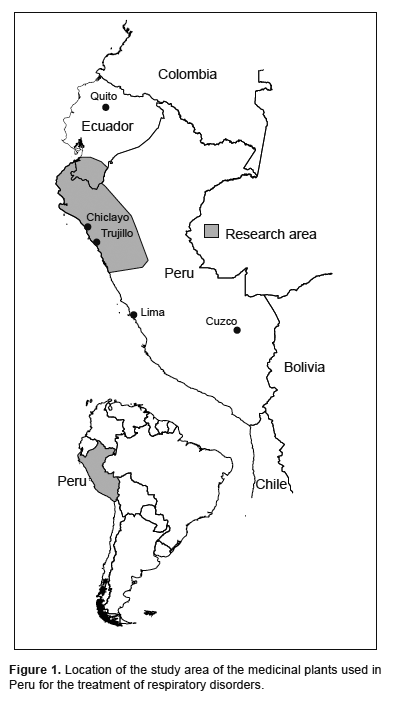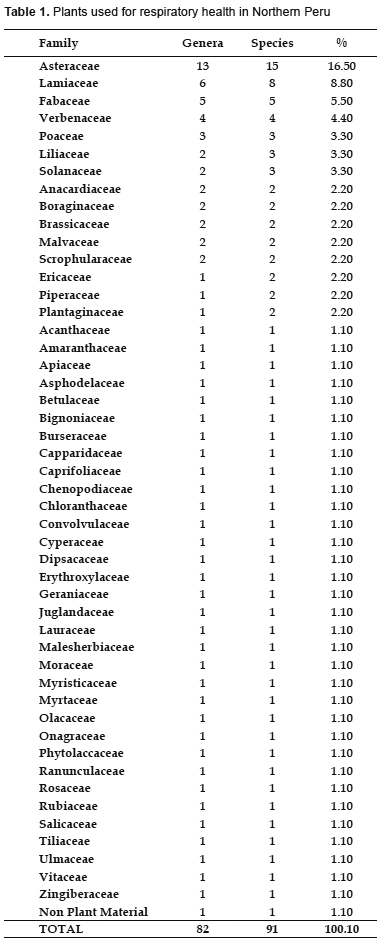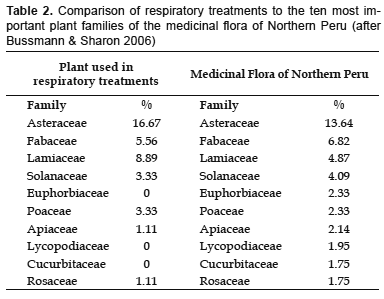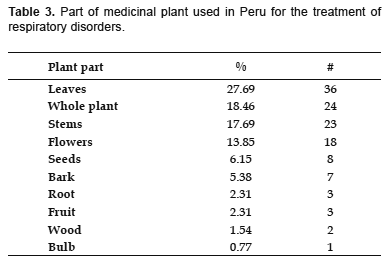Servicios Personalizados
Revista
Articulo
Indicadores
-
 Citado por SciELO
Citado por SciELO
Links relacionados
-
 Similares en
SciELO
Similares en
SciELO  uBio
uBio
Compartir
Revista Peruana de Biología
versión On-line ISSN 1727-9933
Rev. peru biol. v.17 n.3 Lima dic. 2010
Medicinal plants used in Peru for the treatment of respiratory disorders
Plantas medicinales utilizadas en Perú para el tratamiento de enfermedades respiratorias
Rainer W. Bussmann* and Ashley Glenn
Abstract
Respiratory tract infections continue to be a major health challenge worldwide especially due to the increasingly fast development of resistance to the drugs currently in use. Many plant species are traditionally used for respiratory illness treatment, and some have been investigated for their efficacy with positive results. A total of 91 plant species belonging to 82 genera and 48 families were documented and identified as respiratory system herbal remedies in Northern Peru. Most species used were Asteraceae (15 species, 16.67%), followed by Lamiaceae and Fabaceae (8.89% and 5.56%). The majority of respiratory disorder herbal preparations were prepared from the leaves of plants (27.69%), while the whole plant (18.46%), flowers (13.85%) and stems (17.69%) were used less frequently. In almost 55% of the cases fresh plant material was used to prepare remedies. About 86% of the remedies were applied orally, while the remaining ones were applied topically. Over half of all remedies were prepared as mixtures of multiple ingredients. Almost 50% of the plants found in the respiratory pharmacopoeia of Northern Peru, or their congeners have been studied for their medicinal properties. The results of this study show that both indigenous and introduced species are used for the treatment of respiratory system disorders. The information gained on frequently used traditional remedies might give some leads for future targets for further analysis in order to develop new drugs.
Keywords: Ethnobotany, tradicional medicine, Peru, bronchitis, pneumonia, cold, cough, tuberculosis.
Resumen
Las infecciones del sistema respiratorio continúan siendo un desafió en sistemas de salud, en particular porque ellas desarrollan resistencia a los antibióticos más usados. Varias plantas medicinales son utilizadas en sistemas tradicionales de salud para el tratamiento de enfermedades respiratorias, incluso algunas de ellas han sido investigadas para verificar su eficacia. En este estudio registramos 91 especies de plantas de 82 géneros y 48 familias, utilizadas como medicina para el sistema respiratorio. Las especies más usadas pertenecieron a la familia Asteraceae (15 species, 16,67%), seguido por Lamiaceae y Fabaceae (8,89% y 5,56%). En los preparados para problemas respiratorios se utilizaron con más frecuencia hojas de plantas (27,69%), seguido de la planta entera (18,46%), flores (13,85%) y tallos (17,69%). En el 55% de los preparados se utilizó material fresco, y el 86% de los preparados se administraron por vía oral, y más de la mitad fueron preparados como mixturas de diferentes especies. Casi el 50% de las plantas que se encuentran en la farmacopea respiratoria del norte del Perú, o de sus congéneres, ya han sido estudiados por sus propiedades medicinales. Los resultados de este estudio muestran que se usan especies introducidas y nativas, y que la información obtenida de los remedios tradicionales utilizados puede contribuir al desarrollo de medicamentos nuevos.
Palabras claves: Etnobotanica, medicina tradicional, Perú, bronquitis, neumonía, resfrió, tos, tuberculosis.
Introduction
The WHO reports that respiratory illnesses are of high importance as a cause of death and morbidity at a global scale in Peru respiratory problems are a major cause for infant deaths (WHO 2006).
Traditional Medicine is used globally and is rapidly growing in economic importance. In developing countries, Traditional Medicine is often the only accessible and affordable treatment available. The WHO reports that Traditional Medicine is the primary health care system for important percentage of the population in developing countries. In Latin America, the WHO Regional Office for the Americas (AMRO/PAHO) reports that 71% of the population in Chile and 40% of the population in Colombia has used Traditional Medicine. In many Asian countries Traditional Medicine is widely used, even though Western medicine is often readily available. In Japan, 60 _ 70% of allopathic doctors prescribe traditional medicines for their patients.
Complementary Alternative Medicine is also becoming more and more popular in many developed countries. Forty-two percent of the population in the US have used Complementary Alternative Medicine at least once (WHO 1998), and a national survey reported the use of at least one of 16 alternative therapies increased from 34% in 1990 to 42% in 1997 (UNCCD 2000). The number of visits to providers of Complementary Alternative Medicine (CAM) now exceeds by far the number of visits to all primary care physicians in the US (WHO 1999a, 2002b).
The expenses for the use of Traditional and Complementary Alternative Medicine are exponentially growing in many parts of the world. The 1997 out-of-pocket Complementary Alternative Medicine expenditure was estimated at US$ 2,700 million in the USA. The world market for herbal medicines based on traditional knowledge is now estimated at US$ 60,000 million (Breevort 1998).
Northern Peru is believed to be the center of the Central Andean Health Axis (Camino 1992), and traditional medicinal practices in this region are still an important component of everyday life (Bussmann & Sharon 2006, Bussmann 2006, De Feo 1992, Joralemon & Sharon 1993, Polia 1988, Sharon 1978, 1980, 1994, 2000, Sharon & Bussmann 2006). Traditional Medicine is also gaining more and more respect by national governments and health providers. Peru's National Program in Complementary Medicine and the Pan American Health Organization recently compared Complementary Medicine to allopathic medicine in clinics and hospitals operating within the Peruvian Social Security System (EsSalud/ Organización Panamericana de Salud 2000). According to WHO (2002b), the sustainable cultivation and harvesting of medicinal species is one of the most important challenges for the next few years.
The present study attempts to give an overview on medicinal plant species employed in traditional therapies in Northern Peru to treat respiratory problems, and compare this use to the western scientific evidence regarding their efficacy.
Materials and methods
Plant collections
Plants in Peru were collected in the field, in markets, and at the homes of traditional healers (curanderos) in Northern Peru (Fig. 1) in August-September 2001, July-August 2002, July-August 2003, June-August 2004, July-August 2005, July-August 2006, June-August 2007, June-August 2008, March-April 2009 and June-August 2009. A total of 116 informants (healers and market venders) in the Trujillo and Chiclayo area were interviewed using structured questionnaires. The informants were always provided with fresh plant material, either collected with them, by them, or available at their market stands. The questionnaires did not include any reference as to disease concepts, plant parts or preparations. In contrast, the participants were only asked simple questions along the lines "What is this plant used for, which part, which quantity, how is it prepared, are any other plants added to the mixture." All questions were asked in the same order. All informants were of Mestizo origin, and spoke only Spanish as their native language. The study covered the four existing medicinal plant markets of the region, and included all venders present. All interviews were conducted with the same set of participants. The specimens are registered under the collection series "RBU/PL", "ISA", "GER", "JULS", "EHCHL", "VFCHL", "TRUBH", and "TRUVANERICA", depending on the year of fieldwork and collection location. Surveys were conducted in Spanish by fluent speakers. Surveyors would approach healers, collectors and market vendors and explain the premise for the study, including the goal of conservation of medicinal plants in the area.

Vouchers of all specimens were deposited at the Herbario Truxillensis (HUT, Universidad Nacional de Trujillo), and Herbario Antenor Orrego (HAO, Universidad Privada Antenor Orrego Trujillo). In order to recognize Peru's rights under the Convention on Biological Diversity, most notably with regard to the conservation of genetic resources in the framework of a study treating medicinal plants, the identification of the plant material was conducted entirely in Peru. No plant material was exported in any form whatsoever.
Nomenclature
The nomenclature of plant families, genera, and species follows the catalogue of Brako and Zarucchi (1993) and Jørgensen and León-Yanez (1999). The nomenclature was compared to the TROPICOS database. Species were identified using the available volumes of the Flora of Peru (McBride 1936-1981), as well as Jørgensen & Ulloa Ulloa (1994), Pestalozzi (1998) and Ulloa Ulloa & Jørgensen (1993), and the available volumes of the Flora of Ecuador (Sparre & Harling 1978-2009), and reference material in the herbaria HUT, HAO, QCA, LOJA and QCNE.
Results
A total of 91 plant species belonging to 82 genera and 48 families were documented and identified as respiratory system herbal remedies in Northern Peru. Most species used were Asteraceae (15 species, 16.67%), followed by Lamiaceae and Fabaceae (8.89% and 5.56%). Most other families contributed only one species each to the pharmacopoeia (Table 1). A complete overview of all plants encountered, including data on use-recipes and preparation, is given in Appendix 1. The most important families are clearly similarly well represented in comparison to the overall medicinal flora, although some other medicinally important families (e.g. Euphorbiaceae, Lycopodiaceae, Cucurbitaceae) are completely missing from the respiratory portfolio (Table 2) (Bussmann & Sharon 2006).


The majority of respiratory disorder herbal preparations were prepared from the leaves of plants (27.69%), while the whole plant (18.46%), flowers (13.85%) and stems (17.69%) were used less frequently (Table 3, Bussmann & Sharon 2006). This indicates that the local healers count on a very well developed knowledge about the properties of different plant parts. In almost 55% of the cases fresh plant material was used to prepare remedies, which differs little from the average herbal preparation mode in Northern Peru. About 86% of the remedies were applied orally, while the remaining ones were applied topically. Over half of all remedies were prepared as mixtures of multiple ingredients by boiling plant material either in water or in sugarcane spirit.

Discussion
Respiratory disorders are so common globally, and over-the counter remedies, both allopathic and complementary, so frequently sold, that much effort has been put into the verification of traditional remedies. Almost 50% of the plants found in the respiratory pharmacopoeia of Northern Peru, or their congeners have been studied for their medicinal properties. The original hypothesis that many species employed for respiratory illnesses would be non-native, introduced to treat diseases that were originally also introduced by colonialists, did not hold however. Quite contrarily, many remedies for respiratory ailments are native to the study area (Bussmann & Sharon 2006). From this perspective it is surprising to see how many species have actually been studied at least preliminarily. Biella et al. (2008) report on the activity in an extract of Alternanthera. Braga et al. (2007) worked on Schinus molle. Other examples include Apium graveolens (Atta & Alkofahni 1998), Acmella (Hoeltz et al. 2002), Clibadium (Perez-Garcia et al. 2001), Eupatorium (Jaric et al. 2007), Flaveria (Bardón et al. 2007), Perezia (Enríquez et al. 1980), Senecio (Uzun et al. 2004), Tagetes (Caceres et al. 1991), Alnus and Sambucus (Turner & Hebda 1990), Jacaranda (Gachet & Schühly 2000), Raphanus (Ishtiaq et al. 2007), Cordia (Molina-Salinas 2007), Scabiosa (Abad et al. 1996), Bursera (Kumarasamy et al. 2002), Erythroxulum (Weiil 1978), Myroxylon (Linares & Bye 1987), Prosopis (Hebbar et al. 2004), Lanandula (Hajahashemi et al. 2003; Uzun et al. 2004), Cinchona (Rojas et al. 2006), Juglans (Cruz-Vega et al. 2008), Uncaria (Deharo et al. 2004; Heitzmann et al. 2005), Cymbopogon and Cinnamomum (Giron et al. 1991; Wannissorn et al. 2005), Plantago and Eucalyptus (Andrade-Cetto 2008; Rakover et al. 2008), Malva and Alcea (Carmona et al. 2005), Dracaena (Mothana et al. 2006), Allium (Petkov 1986; Bielroy 2004; Al-Momani et al. 2007), Rubus (Rvra & Obón 1995; Ritch-Krc et al. 1996), Stachys (Duarte et al. 2005), Satureja (Caceres et al. 1991; Rediç 2007), Salvia (Ali-Shatayeh et al. 2000) and Thymus (Jariç et al. 2007).
Conclusions
Respiratory tract infections continue to be a major health challenge worldwide especially due to the increasingly fast development of resistance to the drugs currently in use. Many plant species are traditionally used for respiratory illness treatment, and some have been investigated for their efficacy with positive results. An often-limiting factor to these investigations is lack of comprehensive ethnobotanical data to help choose plant candidates for potency/efficacy tests. Since the plant parts utilized in preparation of remedies are reported in this survey, it serves as an indication of species that may need further ecological assessment on their regeneration status.
The results of this study show that both indigenous and introduced species are used for the treatment of respiratory system disorders. The information gained on frequently used traditional remedies might give some leads for future targets for further analysis in order to develop new drugs. However, more detailed scientific studies are desperately needed to evaluate the efficacy and safety of the remedies employed traditionally.
Acknowledgements
The presented study was financed through MIRT/MHIRT (Minority Health Disparity International Research and Training) a grant from the National Institutes of Health (Fund: 54112B MHIRT Program, Grant: G0000613). Fieldwork for this project was supported through the assistance of a large number of MIRT/MHIRT students and volunteers. Thanks to all of them. None of the work would have been possible without the invaluable collaboration of Douglas Sharon and our Peruvian colleagues, especially curanderas Julia Calderón, Isabel Chinguel, and Olinda Pintado, curanderos Germán Santisteban and Leoncio Carrión, and herbalists Manuel Bejarano, Elmer Cruz, and Iván Cruz. Thanks also go to Eric Rodriguez (Herbarium Truxillense, HUT) and Abundio Sagastegui, Segundo Leiva, and Mario Zapata (Herbario Antenor Orrego, HAO) for the use of their facilities and their assistance in plant identification.
Literature cited
Abad M.J., P. Bermejo, E. Carretero, et al. 1996. Antiinflammatory activity of some medicinal plant extracts from Venezuela. J. Ethnopharmacol. 55(1): 63-68.
Ali-Shatayeh M.S., Z. Yaniv & J Mahajna. 2000. Ethnobotanical survey in the Palestinian area: a classification of the healing potential of medicinal plants. J. Ethnopharmacol. 73(1-2): 221-232.
Al-Momani W., E. Abu-Bsaha, S. Janakat, R.A. Nicholas & R.D Ayling. 2007. In vitro antimycoplasmal activity of six Jordanian medicinal plants against three Mycoplasma species. Trop Anim Health Prod. 39(7): 515-519.
Andrade-Cetto A. 2008. Ethnobotanical study of the medicinal plants from Tianchinol, Hidalgo, Mexico. J. Ethnopharmacol. 122(1): 163-71.
Atta A.H. & A Alkofahi. 1998. Anti-nociceptive and anti-inflammatory effects of Jordanian medicinal plant extracts. J. Ethnopharmacol. 60(2): 117-124.
Bardón A., S. Borkosky, M.I. Ybarra, S. Montanaro & E Cartagena. 2007. Bioactive plants from Argentina and Bolivia. Fitoterapia 78(3): 227-231.
Biella Cde A., M.J. Salvador, D.A. Dias, M. Dias-Baruffi & L.S Pereira-Crott. 2008. Evaluation of immunomodulatory and anti-inflammatory effects and phytochemical screening of Alternanthera tenella Colla (Amaranthaceae) aqueous extracts. Mem. Inst. Oswaldo Cruz 103(6): 569-577
Bielroy L. 2004. Complementary and alternative interventions in asthma, allergy and immunology. Ann Allergy Asthma Immunol. 93(2 Suppl 1): 45-54.
Braga F.G., M.L. Bouzada, R.L. Fabri, M. et al. 2007. Amteileishmanial and antifungal activity of plants used in traditional medicine in Brazil. J. Ethnopharmacol. 111(2): 396-402.
Brako L. & J.L. Zarucchi (Eds,), 1993. Catalogue of the Flowering Plants and Gymnosperms of Peru. Missouri Botanical Garden, Saint Louis, MO.
Breevort P., 1998. The Booming U. S. Botanical Market: A New Overview. HerbalGram 44: 33-46.
Bussmann R.W., 2006. Manteniendo el balance de naturaleza y hombre, La diversidad florística andina y su importancia por la diversidad cultural _ ejemplos del Norte de Perú y Sur de Ecuador. Arnaldoa 13(2): 382-397.
Bussmann R.W. & D. Sharon. 2006. Traditional plant use in Northern Peru, Tracking two thousand years of health culture. Journal of Ethnobiology and Ethnomedicine 2,47.
Caceres A., A.V. Alvarez, A.E. Ovando & B.E. Samayoa. 1991. Plants used in Guatemala for the treatment of respiratory diseases. 1. Screening of 68 plants against gram-positive bacteria. J. Ethnopharmacol. 31(2): 193-208.
Camino L., 1992. Cerros, plantas y lagunas poderosas, la medicina al norte de Perú. Lima, Lluvia Editores.
Carmona M.D., R. Llorach, C. Obon & D. Rivera. 2005. "Zahraa", a Unami multicomponent herbal tea widely consumed in Syria: components of drug mixtures and alleged medicinal properties. J. Ethnopharmacol. 102(3): 344-350.
Cruz-Vega D.E., M.J. Verde-Star, N. Salinas-González, et al.2008. Antimycobacterial activity of Juglans regia, Juglans mollis, Carya illinoensis and Boconia frutescens. Phtother. Res. 22(4): 557-559.
De Feo V., 1992. Medicinal and magical plants on northern Peruvian Andes. Fitoterapia 63: 417_440.
Deharo E., R. Baelmans, A. Gimenez, C. Quenevo & G. Bourdy. 2004. In vitro immunomodulary activity of plants used by the Tacana ethnic group in Bolivia. Phytomedicine 11(6): 516-522.
Duarte M.C., G.M. Fugueira, A. Sartoratto, V.L. Rehder & C. Delarmelina. 2005. Anti- Candida activity of Brazilian medicinal plants. J. Ethnopharmacol. 97(2): 305-311.
Enríquez R., J. Ortega & X. Lozoya. 1980. Active components of Perezia roots. J. Ethnopharmacol.2(4): 389-393.
EsSalud/Organización Panamericana de Salud. 2000. Estudio Costo-Efectividad: Programa Nacional de Medicina Complementaria. Seguro Social de EsSalud (Study of Cost- Effectiveness: National Program in Complementary Medicine. Social Security of EsSalud). Lima, EsSalud/Organización Panamericana de Salud (Pan American Health Organization).
Gachet M.S. & W. Schühly. 2000. Jacaranda _ An ethnopharmacological and phytochemical review. J. Ethnopharmacol. 121(1): 14-27.
Girón L.M., V. Freire, A. Alonzo & A. Cáceres. 1991. Ethnobotanical survey of the medicinal flora used by the Caribs in Guatemala. J. Ethnopharmacol. 34(2-3): 173- 187.
Hajhashemi V., A. Ghannadi & B. Sharif. 2003. Anti-inflammatory and analgesic properties of the leaf extracts and essential oils of Lavandula angustifolia Mill. J. Ethnopharmacol.89(1): 67-71
Hebbar S.S., V.H. Harsha, V. Shripathi & G.R. Hedge. 2004. Ethnomedicine of Dharwad district in Karnataka, India _ plants usd in oral health care. J. Ethnopharmacol. 94(2- 3): 261-266.
Heitzman M.E., C.C. Neto, E. Winiarz, A.J. Vasiberg& G.B. Hammond. 2005. Ethnobotany, phytochemistry and pharmacology of Uncaria (Rubiaceae) Phytochemistry 66(1): 5- 29.
Holetz F.B., G.L. Pessini, N.R. Sanches, D.A. Cortez, C.V. Nakamura & B.P. Filho. 2002. Screening of some plants used in the Brazilian folk medicine for the treatment of infectious diseases. Mem. Inst. Oswaldo Cruz 97(7): 1027-1031.
Ishtiaq M., W. Hanif, M.A. Khan, A. Ashraf & A.M. Butt. 2007. An ethnomedicinal survey and documentation of important medicinal folklore food phytonims of flora of Samahni valley, (Azad Kashmir) Pakistan. Pak. J. Biol. Sci. 10(13): 2241-2256.
Jari? S., Z. Popovi?, M. Macunkanovi?-Jovi?, et al. 2007. An ethnobotanical study on the usage of wild medicinal herbs from Kapaonik Mountain (Central Serbia) J. Ethnopharmacol. 111(1): 160-175
Joralemon D. & D. Sharon. 1993. Sorcery and Shamanism, Curanderos and Clients in Northern Peru. University of Utah Press, Salt Lake City.
Jørgensen P.M. & S. León-Yanez (Eds.), 1999. Catalogue of the vascular plants of Ecuador. - Monographs in Systematic Botany from the Missouri Botanical Garden 75.
Jørgensen P.M. & C. Ulloa Ulloa. 1994. Seed plants of the High Andes of Ecuador - a Checklist. AAU Reports 34: 1-443.
Kumarasamy Y., P.J. Cox, M. Jaspars,.L. Nahar & S.D. Sarker. 2002. Screening seeds of Scottish plants for antibacterial activity. J. Ethnopharmacol. 83(1-2): 73-77.
Linares E. & R.A. Bye Jr. 1987. A study of four medicinal plant complexes of Mexico and the adjacent United States. J. Ethnopharmacol. 19(2): 153-183.
McBride J.F. (Ed,), 1936-1981. Flora of Peru. Fieldiana, Botany. Field Museum of Natural History, Chicago.
Molina-Salinas G.M., A. Pérez-López, P. Becerril-Montes, et al. 2007. Evaluation of the flora of northern Mexico for in vitro antimicrobial and antituberculosis activity. J. Ethnopharmacol. 109(3): 435-441.
Mothana R.A., R. Metel, C. Reiss & U. Lindequist. 2006. Phytochemical screening and antiviral activity of some medicinal plants from the island Socotra. Phytother. Res. 20(4): 298-302.
Pérez-Garcia F., E. Martin, T. Adzet & S. Cañigueral. 2001. Acticity of plant extracts on the respiratory burst and the stress protein synthesis. Phytomedicine 8(1): 31-38
Pestalozzi H.U., 1998. Flora ilustrada altoandina. Herbario Nacional de Bolivia and Herbario Forestal Nacional Martín Cardenas, Cochabamba.
Petkov V. 1986. Bulgarian traditional medicine: a source of ideas for phytopharmacological investigations. J. Ethnopharmacol. 15(2): 121-132.
Polia M., 1988. Las Lagunas de los Encantos _ Medicina Tradicional Andina en el Peru septentrional. Lima, CePeSer.
Rakover Y., E. Ben-Ayre & L.H. Goldstein. 2008. The treatment of respiratory ailments with essential oils of some aromatic medicinal plants. Harefuah 147(10): 783-788, 838.
Redziç S. 2007. The ecological aspects of ethnobotany and ethnopharmacology of population in Bosnia and Herzegovina. Coll. Antropol. 31(3): 869-890.
Ritch-Krc E.M., S. Thomas, N.J. Turner & G.H. Towers. 1996. Carrier herbal medicine: traditional and contemporary plant use. J. Ethnopharmacol. 52(2): 85-94.
Rojas J.J., V.J. Ochoa, S.A. Ocampo & J.F. Muñoz. 2006. Screening for antimicrobial activity of ten medicinal plants used in Colombian folkloric medicine: a possible alternative in the treatment of non-nosocomial infections. BMC Complement. Altern. Med. 6: 2.
Rvra D. & C. Obón. 1995. The ethnopharmacology of Madeira and Porto Santo Islands, a review. J. Ethnopharmacol. 46(2): 73-93.
Sharon D. 1978. Wizard of the Four Winds, A Shaman's Story. Free Press, New York.
Sharon D. 1980. El Chamán de los Cuatro Vientos. Siglo veintiuno editores, México, D.F.
Sharon D. 1994. Tuno y sus colegas, notas comparativas. In; Millones L., Lemlij M. (Eds.), En el Nombre del Señor, Shamanes, demonios y curanderos del norte del Perú. Australis S.A., Lima pp.128-147.
Sharon, D. 2000. Shamanismo y el Cacto Sagrado - Shamanism and the Sacred Cactus. San Diego Museum Papers 37.
Sharon D. &, R.W. Bussmann. 2006. Plantas Medicinales en la Obra del Obispo Don Baltasar Jaime Martínez Compañon (Siglo XVIII). In, Millones L. & T. Kato (Eds), Desde el exterior, El Perú y sus estudios. Tercer Congreso Internacional de Peruanistas, Nagoya,UNMSM, FEFCS, Lima, pp. 147-165.
Sparre G. & B. Harling. 1978-2009. Flora of Ecuador (various authors). Council for Nordic Publications in Botany. Botanical Museum, Copenhagen, Denmark.
Turner N.J. & R.J. Hebda. 1990. Contemporary uses of bark for medicine by two Salishan native elders of southeast Vancouber Island, Canada. J. Ethnopharmacol. 29(1): 59- 72.
Ulloa Ulloa C. & P.M., Jørgensen. 1993. Árboles y arbustos de los Andes del Ecuador. AAU Reports 30: 1-263.
UNCCD (United Nations Conference on Trade and Development). 2000. Systems and National Experiences for Protecting Traditional Knowledge, Innovations and Practices. Background Note by the UNCTAD Secretariat. Geneva, United Nations Conference on Trade and Development, (document reference TD/B/COM.1/EM.13/2).
Uzun E., G. Sariyar, A. Andersen, B. Karakoc, G. Otük, E. Oktayoglu & S. Pirildar. 2004. Traditional medicine in Sakarya province (Turkey) and antimicrobial activities of selected species. J. Ethnopharmacol. 95(2-3): 287-296.
Wannissorn B., S. Jarikasem, T. Siriwangchai & S. Thubthimthed. 2005. Antibacterial properties of essential oils from Thai medicinal plants. Fitoterapia 76(2): 23-236.
Weil A.T. 1978. Coca leaf as therapeutic agent. Am J Drug Alcohol Abuse 5(1):75-86.
WHO (World Health Organization). 1998. Report, Technical Briefing on Traditional Medicine. Forty-ninth Regional Committee Meeting, Manila, Philippines, 18 September 1998. Manila, WHO Regional Office for the Western Pacific.
WHO (World Health Organization). 1999a. Consultation Meeting on Traditional Medicine and Modern Medicine, Harmonizing the Two Approaches. Geneva, World Health Organization, (document reference (WP)TM/ICP/TM/001/RB/98_ RS/99/GE/32(CHN)).
WHO (World Health Organization). 1999b. Traditional, Complementary and Alternative Medicines and Therapies. Washington DC, WHO Regional Office for the Americas/Pan American Health Organization (Working group OPS/OMS).
WHO (World Health Organization). 2002a. Implementation of the WHO Strategy for Prevention and Control of Chronic Respiratory Diseases. WHO/MNC/CRA/O2.2.
WHO (World Health Organization). 2002b. WHO Traditional Medicine Strategy 2002_2005. World Health Organization, Geneva.
WHO (World Health Organization). 2006. Mortality Country fact sheet Peru 2006. World Health Statistics 2006
Appendix 1

Correspondencia:
William L. Brown Center, Missouri Botanical Garden,
P.O. Box 299, St. Louis, MO 63166-0299, USA,
Office phone: +1-314-577-9503, Fax: +1-314-577-0800.
Email Rainer Bussmann: rainer.bussmann@mobot.org
Presentado: 01/06/2010
Aceptado: 22/11/2010
Publicado online: 21/01/2011













